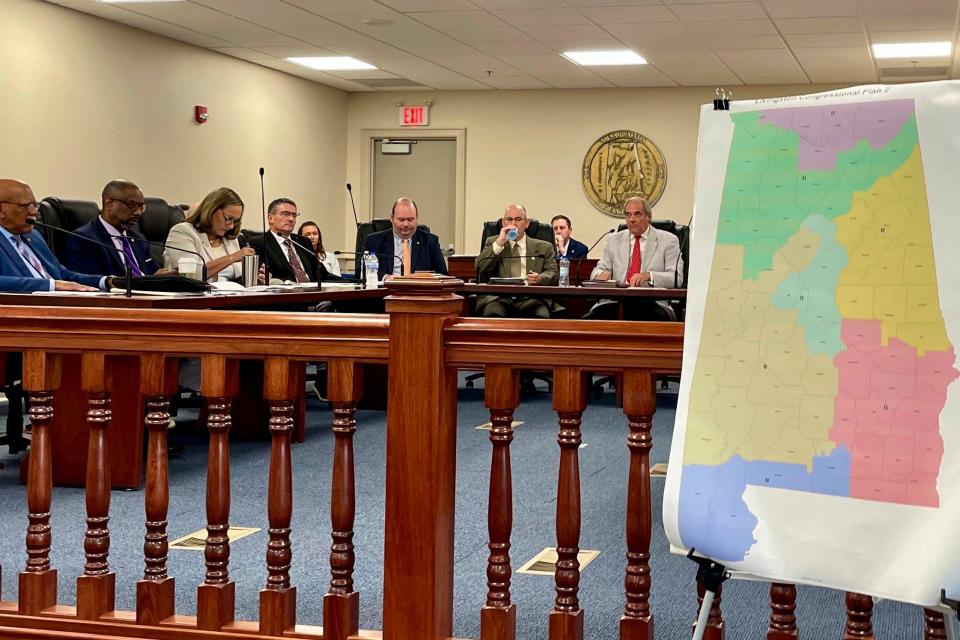Can Democrats capitalize on their congressional success? | INSIDE THE STATEHOUSE
- Oops!Something went wrong.Please try again later.
- Oops!Something went wrong.Please try again later.
It’s official and final: Alabama will elect seven member congressional delegation under new lines next year. The federal court has spoken. The special master drawing the lines has acted and the final omnipotent power, the U.S. Supreme Court, has concurred and confirmed the decision. It is over.
The result that the plaintiffs desired has been decreed by the courts. There will be a new second majority Black congressional district. This accomplishment has been sought for decades.
More: Why roads and bridges have been vital for Alabama | INSIDE THE STATEHOUSE
Now the question becomes, can the Democrats succeed in electing a Black Democrat to this new opportunity district? It is not a slam dunk.
The new district is 50% Black and 50% White. It favors a Montgomery candidate. The bulk of the population and the geographic center of the new district is Montgomery County. Montgomerians are like the rest of the state, they adhere to the well-known predilection known as “friends and neighbors” politics. That means they prefer to vote for someone from their neck of the words, especially their county.
My early prediction is that Montgomery's mayor, Steven Reed, will be the Democratic nominee and will be the favorite to win the new seat.

The special master that drew the new lines attached an index to his maps that revealed that if there were a congressional race within this new district that this district would have voted for the Democrat in 15 out of the last 17 elections. Therefore, the court’s desire to make a second minority Democratic district where a Democrat has a good opportunity to win has been accomplished.
The entire basis of this high-profile federal case has been centered on the fact that Alabama has one Black Democratic congresswoman, Terri Sewell, and six White Republicans. One Black Democrat constitutes 14% of the state’s population. The plaintiff’s argument that the state’s Black population is 27%. Therefore, there should be two Black Democratic congressional seats in the Heart of Dixie.
The courts bought that argument and hung their hat on the 1965 Voting Rights Act and having one seat rather than two violates and dilutes Black voters in Alabama’s voting rights.
The question now becomes, what are the down-home political implications and results of these court-mandated new congressional lines? All of you who live in middle and north Alabama, which is most of you, are unaffected. The majority of the people in Alabama, who live in Birmingham north are not affected. In fact, everyone north of Montgomery is unaffected. All of the commotion and redrawing has occurred in Montgomery, the Black Belt, the Wiregrass, and Mobile.
Our three powerful Republican congressmen are left with basically their same districts. Republicans Robert Aderholt, Mike Rogers and Gary Palmer, who are our centers of power in the House, have their same, if not enhanced, GOP districts. The district of Huntsville’s freshman congressman, Dale Strong, is unchanged.
Sewell’s Democratic-leaning district has been favored in the drawings. She has a perfectly drawn district that pretty much mirrors her current Birmingham-based seat. She will probably be spared a Republican challenge.
However, state Sen. Bobby Singleton, who hails from the Black Belt, may challenge her in a Democratic primary out of spite. He wanted a district that favored him, but lost to Sewell in the legislative battles over the drawing of the new Black district.
The real rubber meets the road within the Republican ranks in the Wiregrass, and Mobile and Baldwin counties. The five Wiregrass counties of Covington, Dale, Geneva, Houston, and Coffee are sent to Baldwin and Mobile. Therefore, Jerry Carl, the new congressman from Mobile, and Barry Moore from Enterprise/Coffee are in the same district.
Moore is the odd man out in this dilemma. The majority of votes in this new district are in Baldwin and Mobile counties. Carl will be the prohibitive favorite against Moore, or any other Republican. It will be a very conservative Republican district. Therefore, six of our seven seats will be in safe reelection journeys for our incumbent congressmen.
Jerry Carl in the 1st, Mike Rogers in the 3rd, Robert Aderholt in the 4th, Strong in the 5th, Palmer in the 6th, and Sewell in the seventh are very safe bets for reelection in 2024. Therefore, all of the turmoil and court intervention only affects one area of the state.
All the brouhaha and action will be in the newly drawn 2nd district. it is Reed’s race to lose, as Montgomery's Democratic mayor. He will be the favorite to win and change Alabama’s delegation in Washington from six Republicans and one Democrat to five Republicans and two Democrats.
However, I would handicap that race as a 50/50 toss-up. There will be a lot of Republican dollars from Washington showered upon the Republican nominee. It will be interesting.

Steve Flowers is Alabama’s leading political columnist. His weekly column appears in over 60 Alabama newspapers. He served 16 years in the state legislature. Steve can be reached at www.steveflowers.us.
This article originally appeared on The Tuscaloosa News: Can Democrats capitalize on their success? | INSIDE THE STATEHOUSE

